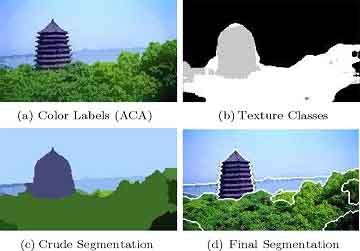Adaptive perceptual color-texture image segmentation
Junqing Chen, Thrasyvoulos Pappas
Sourse of information: http://spie.org/x8899.xml?ArticleID=x8899
By combining knowledge of human perception with an understanding of signal characteristics, natural scenes can be segmented into perceptually/semantically uniform regions.
 Image
segmentation has been one of the fundamental problems since the birth of
computer vision. It provides the foundation for object-based image/video
processing. Of particular interest when we developed our method is the
content-based image retrieval (CBIR) system. Image segmentation remains an
open research topic, especially the segmentation of natural scenes. Much of
the difficulty in segmenting these types of images is due to the intrinsic
complexities and uniformities in terms of low-level features such as texture
and color (see, for example, Deng and Manjulath1). Another challenging
aspect of image segmentation is the extraction of information that's
perceptually relevant to humans (the ultimate users of many of these
applications). This requires the extraction of (low-level) image features
that can be correlated with high-level image semantics.
Image
segmentation has been one of the fundamental problems since the birth of
computer vision. It provides the foundation for object-based image/video
processing. Of particular interest when we developed our method is the
content-based image retrieval (CBIR) system. Image segmentation remains an
open research topic, especially the segmentation of natural scenes. Much of
the difficulty in segmenting these types of images is due to the intrinsic
complexities and uniformities in terms of low-level features such as texture
and color (see, for example, Deng and Manjulath1). Another challenging
aspect of image segmentation is the extraction of information that's
perceptually relevant to humans (the ultimate users of many of these
applications). This requires the extraction of (low-level) image features
that can be correlated with high-level image semantics.
We proposed an image segmentation algorithm that is based on
spatially-adaptive texture features. To this end, we developed two types of
features: one describes the local color composition; the other, the spatial
characteristics of the texture's grayscale component. The algorithm first
develops these features independently and then separates the image into
smooth and textured areas using the spatial texture features. It then
combines the color composition and spatial texture features to consolidate
textured areas into regions.
The color composition features consist of the dominant colors and associated
percentages in the vicinity of each pixel. They are based on the estimation
of spatially-adaptive dominant colors. This takes into account the fact that
the human visual system cannot simultaneously perceive a large number of
colors, and that region colors are spatially varying. This technique is
superior to previous approaches based on the concept of extracting the
dominant colors in the image by addressing the issue of spatial variations,
one of the most common characteristics for images of natural scenes.
Spatially-adaptive dominant colors can be obtained using the local intensity
functions of the adaptive clustering algorithm (ACA). The perceptual
similarity of the color composition features is determined by a modified
optimal-color-composition-distance (OCCD) metric.
The spatial-texture features are based on a multiscale frequency
decomposition with four orientation subbands (horizontal, vertical, and
±45°). We use the local energy of the subband coefficients as a simple but
effective characterization of spatial texture. An important novelty of the
proposed approach is that a median filter operation is used to distinguish
the energy due to region boundaries from the energy of the textures
themselves. We also show that, while the proposed approach depends on the
structure of the frequency decomposition, it is relatively independent of
the detailed filter characteristics.
The proposed segmentation algorithm combines the color composition and
spatial texture features to obtain segments of uniform texture. This is done
in two steps. The first relies on a multi-grid region growing algorithm to
obtain a crude segmentation, Figure 1(a) The segmentation is crude due to
the fact that the estimation of the spatial and color composition texture
features requires a finite window. The second step uses an elaborate
border-refinement procedure to obtain accurate and precise border
localization by appropriately combining the texture features with the
underlying ACA segmentation. This is shown in Figure 1(b).

Figure 1. Color and texture image segmentation
Several critical parameters of the texture features and segmentation
algorithm can be determined by subjective tests. These include thresholds
for the smooth/non-smooth classification, for determining the dominant
orientation, and for the color composition feature similarity. The goal of
the tests is to relate human perception of isolated (context-free) texture
patches to the statistics of natural textures. Experimental results
demonstrate that this perceptual tuning leads to significant improvements in
segmentation performance.(For details of the algorithm please refer to Chen
et al.
We are currently in the process of identifying category descriptors for
regions that are obtained through the segmentation algorithm. We will then
interpret the overall scene based on region descriptors. Once perfected,
this technique will impact many applications, including CBIR systems.
Authors
Junqing Chen
Unilever Research and Development,
Trumbull, CT
Thrasyvoulos Pappas
Department of Electrical Engineering and Computer Science
Northwestern University
Evanston, IL
References:
1. Y. Deng, B. S. Manjunath, Unsupervised segmentation of color-texture
regions in images and video, IEEE Trans. Pattern Analysis and Machine
Intelligence, Vol: 23, pp. 800-810, 2001.
2. W. Y. Ma et al, Tools for texture/color based search of images, Proc.
SPIE, Vol: 3016, pp. 496-507, 1997.
3. T. N. Pappas, An adaptive clustering algorithm for image segmentation,
IEEE Trans. Signal Processing SP, Vol: 40, pp. 901-914, 1992.
4. A. Mojsilović, Extraction of perceptually important colors and similarity
measurement for image matching, retrieval, and analysis, IEEE Trans. Image
Processing, Vol: 11, pp. 1238-1248, 2002.
5. http://www.eecs.northwestern.edu/
6. J. Chen, Adaptive perceptual color-texture image segmentation, IEEE
Trans. Pattern Analysis and Machine Intelligence, Vol: 14, pp. 1524-1536,
2005.